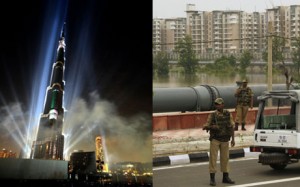By Richard Spencer www.blogs.telegraph.co.uk
Little noticed in the furore over the state of facilities for the Commonwealth Games in New Delhi and in particular the Athletes’ Village is that the contractor who built the Village is the Dubai developer behind the world’s tallest building, the Burj Khalifa.

You might think there were two odd things about this. One is that it has been little noticed. The other is that there is something of a contrast between the glitz of the Burj Khalifa, with its Dubaian (Dubish?) trappings of expensive souvenirs, Armani hotel and Armani-designed apartments up for sale, and Delhi’s “filthy” rooms and unworking toilets.
Well, there are different views: this writer seemed to think the Village was great.
But there’s another connection, best revealed in the contrast between two press releases from Emaar, the developer concerned, within a week. In the first, Shravan Gupta, the local boss of the Indian subsidiary, described the village as “one of the finest Games Villages ever built, be it in design, quality or scale. The Village, as it stands today, is a shining example of blending sustainable building techniques with modern amenities.” He was particularly enamoured of its “superior finishes”.
Then, just six days later, after the row about the facilities hits the world’s TV screens, Emaar suddenly does a wonderful volte face. All the glory they were claiming on September 16 by yesterday was, strangely, little to do with them at all.
It only did the basic stuff, you see. “The Organising Committee is responsible for the furniture and fixtures to be provided in the apartments and the temporary overlays in the Village”, it said – that’s presumably the superior finishes, then.
The art of blatant PR bull was one of the credit bubble’s finest creations, taken to its apogee in Dubai, where for some years investors seemed quite happy to look at a patch of desert with a crane attached, glance at a brochure showing luxury villas surrounded by trees, parks, lakes and swimming pools, and decide the brochure was a better reflection of reality than their own eyes. In this they were expertly encouraged by the developers’ PR people, who, when things went wrong, seemed to disappear.
The opening of the Burj Khalifa itself was repeatedly delayed – even the New Delhi athletes village would look spanking if given another six months, I’d wager – and while we continued to receive emails gushing about how positively super everything was, attempts to get information on when residents could move in suddenly became very difficult indeed.
The reason the connection between the Burj and the Games has been little noticed, by the way, is also simple. You won’t find much mention in the local press. Gulf News, the main English-language paper in these parts, has bizarrely covered the whole Games row from Dubai, despite having pages of reportage from the sub-continent every day for its large Indian and Pakistani readership. Yet I have found no mention of Emaar.
Maybe they would think it “irresponsible”. The Gulf News business pages today did contain this sub-headline, over coverage of a speech about the strength of the Dubai financial system from the governor of the Dubai International Finance Centre, Ahmad Humaid al-Tayer: “Al Tayer calls on the media to report responsibly and objectively on events”.
“Reporting irresponsibly” is one of Dubai’s main charges against international journalists like me who have pointed out that all has not been rosy in certain parts of the Dubai economy in the last 18 months.
You won’t of course get the Gulf News reporting irresponsibly on financial events in Dubai. As the article didn’t point out, Gulf News is part-owned by Mr al-Tayer’s brother, Obaid Humaid al-Tayer, who also happens to be minister for financial affairs.
Some people have suggested that the incompetence surrounding the Delhi games is because of the nature of its democracy, comparing preparations unfavourably to the Beijing Olympics. I would suggest that the inability to look the obvious in the face is more closely related to an unholy alliance between governments and PR machines.













